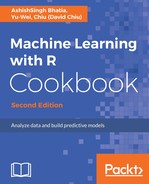The idea of boosting is to boost weak learners (for example, a single decision tree) into strong learners. Assuming that we have n points in our training dataset, we can assign a weight, Wi (0 <= i <n), for each point. Then, during the iterative learning process (we assume the number of iterations is m), we can reweigh each point in accordance with the classification result in each iteration. If the point is correctly classified, we should decrease the weight. Otherwise, we increase the weight of the point. When the iteration process is finished, we can then obtain the m fitted model, fi(x) (0 <= i <n).
Finally, we can obtain the final prediction through the weighted average of each tree's prediction, where the weight, b, is based on the quality of each tree:

Both bagging and boosting are ensemble methods which combine the prediction power of each single learner into a strong learner. The difference between bagging and boosting is that the bagging method combines independent models but boosting performs an iterative process to reduce the errors of preceding models by predicting them with successive models.
In this recipe, we demonstrate how to fit a classification model within the boosting method. Similar to bagging, one has to specify the formula and the training dataset used to train the classification model. In addition, one can specify parameters, such as the number of iterations (mfinal), the weight update coefficient (coeflearn), the weight of how each observation is used (boos), and the control for rpart (a single decision tree). In this recipe, we set the iteration to 10, using Freund (the AdaBoost.M1 algorithm implemented method) as coeflearn, boos set to false and max depth set to 3 for rpart configuration.
We use the boosting method to fit the classification model and then save it in churn.boost. We can then obtain predicted labels using the prediction function. Furthermore, we can use the table function to retrieve a classification table based on the predicted labels and testing the dataset labels. Lastly, we can get the average errors of the predicted results.
